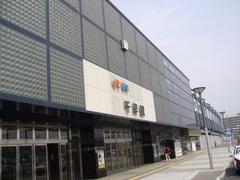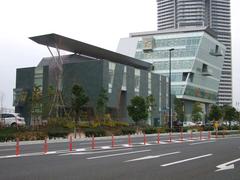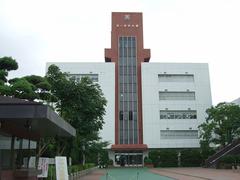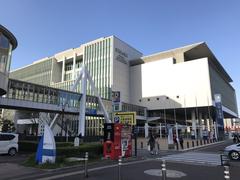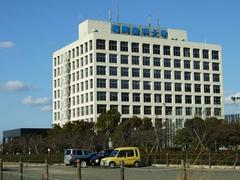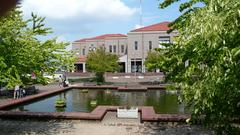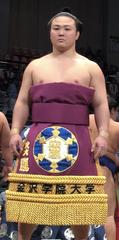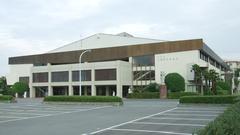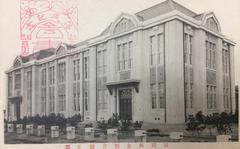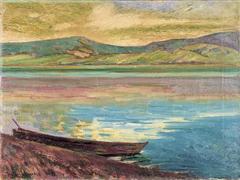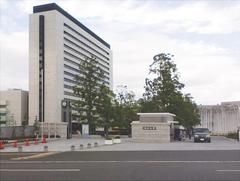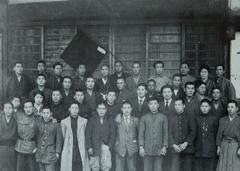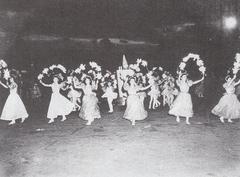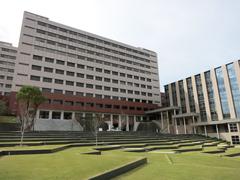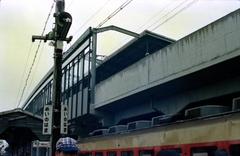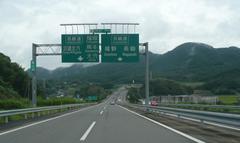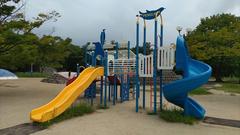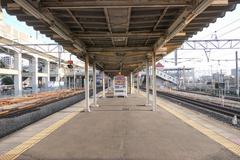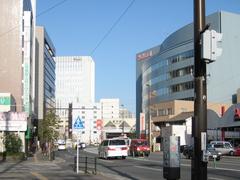Baikōen-Danchi Visiting Hours, Tickets, and Historical Significance in Fukuoka
Date: 04/07/2025
Introduction
Baikōen-Danchi, translating to “Plum Light Garden,” is a distinctive residential district within Fukuoka City that captures the spirit of Japan’s postwar urban transformation. Established during the 1950s–60s danchi movement, Baikōen-Danchi stands as a living example of modern communal living and postwar city planning. Unlike typical tourist attractions, it invites visitors to immerse themselves in authentic suburban Japanese life, complete with thoughtfully designed green spaces, communal facilities, and a vibrant neighborhood culture that continues to thrive.
Fukuoka itself is a city of rich historical layers, functioning as a critical gateway between Japan and the Asian continent for over two millennia. The city’s evolution—from the Yayoi period settlements through its medieval trade prominence at Hakata Port, to its modern role as an industrial and academic hub—provides the broader context for understanding Baikōen-Danchi’s unique place in the urban landscape. The district’s characteristic mid-rise apartments, rows of plum trees, and accessible gardens reflect a harmonious blend of tradition and modernity.
This comprehensive guide explores Baikōen-Danchi’s historical roots, cultural significance, practical visitor information (including hours, ticketing, and etiquette), and highlights nearby attractions. Whether you’re interested in seasonal plum blossoms, Fukuoka’s historical sites, or local community experiences, Baikōen-Danchi offers a memorable perspective on Japanese suburban life. (Fukuoka City Official Guide, Japan Guide: Danchi, GoFukuoka)
Table of Contents
- Historical Context of Fukuoka: Setting for Baikōen-Danchi
- The Emergence and Historical Background of Baikōen-Danchi
- Cultural Significance and Community Life
- Practical Visitor Information
- Nearby Attractions and Experiences
- Frequently Asked Questions (FAQ)
- Summary and Visitor Recommendations
- Reliable Sources for Further Information
Historical Context of Fukuoka: Setting for Baikōen-Danchi
Fukuoka, on the northern shore of Kyushu, is renowned for its more than 2,000 years of continuous history as Japan’s gateway to Asia. Archaeological sites such as the Itazuke Ruins indicate settled communities from the Yayoi period, underlining Fukuoka’s pioneering role in rice cultivation and early civilization (Fukuoka City Official Guide). Over centuries, its location fostered dynamic trade and cultural exchange, especially through Hakata Port, which flourished as a commercial hub in the medieval era (FISOP History of Fukuoka).
The city’s evolution includes the Mongol invasions of the 13th century, Edo period cultural growth, and the Meiji-era merger of Fukuoka and Hakata. Today, Fukuoka balances ancient temples, castle ruins, and folk museums with cutting-edge architecture and urban vitality (GoFukuoka). Baikōen-Danchi’s development is inseparable from this historical trajectory, reflecting both the city’s modernization and preservation of community ties.
The Emergence and Historical Background of Baikōen-Danchi
Baikōen-Danchi (梅光園団地) emerged during Japan’s postwar economic miracle, as part of the nationwide danchi movement—large-scale public housing complexes built to alleviate urban housing shortages and accommodate migration from rural areas (Japan Guide: Danchi). Established in the late 1950s or early 1960s, Baikōen-Danchi exemplifies the era’s ideals: modern amenities, integrated green spaces, and a focus on fostering community.
The district’s name, “Plum Light Garden,” reflects the Japanese tradition of incorporating nature into residential design. The planned layout includes mid-rise apartments, communal courtyards, and plum trees, symbolizing hope and harmony. Baikōen-Danchi’s creation coincided with Fukuoka’s rapid urbanization, driven by industrial expansion, the rise of educational institutions, and the growth of public infrastructure (Fukuoka City Official Guide). Today, the district is home to a diverse population and stands as a testament to Fukuoka’s resilience and forward-thinking urban planning.
Cultural Significance and Community Life
Baikōen-Danchi is more than just a housing complex—it is a microcosm of Fukuoka’s postwar transformation and a model of community living. The danchi ideal was to create self-sufficient neighborhoods with easy access to schools, parks, shops, and public services (Japan Guide: Danchi). Baikōen-Danchi continues this legacy, with communal gardens, seasonal festivals, and neighborhood associations fostering strong social bonds.
Cultural activities abound, from local markets to hanami (flower viewing) during the plum blossom season. Intergenerational ties remain strong, and the area’s green spaces reinforce traditional values of harmony with nature. Its proximity to historical sites such as Fukuoka Castle Ruins and Ohori Park enriches the district’s cultural fabric (GoFukuoka: Exploring Fukuoka Castle).
Practical Visitor Information
Access and Transportation
Baikōen-Danchi is easily reached using Fukuoka’s public transportation, including the subway (Yakuin-ōdōri or Ropponmatsu stations) and local buses (GoFukuoka: Transportation). The area is also bike-friendly and accessible from major hubs like Hakata Station and Tenjin.
Visiting Hours and Tickets
As a residential district, Baikōen-Danchi is open to the public with no entrance fees or ticket requirements. Public gardens and parks are accessible during daylight hours (typically 7:00 AM to 7:00 PM). Community centers may have specific opening times and may require advance reservation for workshops or cultural classes.
What to See and Do
- Stroll the Plum Gardens: Enjoy the scenic beauty of blooming plum trees from late February to early March.
- Participate in Local Events: Attend community festivals, flea markets, or cultural workshops (check local bulletin boards for schedules).
- Experience Everyday Life: Visit local shops, bakeries, and markets to sample Fukuoka’s culinary delights (GoFukuoka: Food Culture).
- Explore Nearby Attractions: Combine your visit with Ohori Park, Fukuoka Castle Ruins, or the Fukuoka City Museum for a deeper understanding of the city’s past and present (GoFukuoka: Must See).
Accessibility
Baikōen-Danchi was designed to be accessible, with wide walkways, ramps, and elevators in most apartment complexes. Public spaces are suitable for visitors of all ages and mobility levels.
Etiquette and Cultural Considerations
- Respect residents’ privacy and keep noise low.
- Do not enter private property; public gardens and parks are open for exploration.
- Photography is allowed in public areas, but always ask before photographing residents or private gardens (GoFukuoka: Travel Etiquette).
- Remove shoes when entering certain community spaces, and observe local customs.
Best Times to Visit
The plum blossom season (late winter/early spring) offers the most picturesque scenery. Autumn is also pleasant, while weekdays are generally quieter than weekends.
Nearby Attractions and Experiences
Baikōen-Danchi’s central location makes it an excellent base for exploring Fukuoka’s major historical and cultural sites:
- Ohori Park: Traditional gardens, a large pond, and scenic walking trails. Open daily, free entry (Klook).
- Fukuoka Castle Ruins: Adjacent to Ohori Park, offering historical insights and panoramic views.
- Fukuoka Tower: Observation decks with city and bay views; ticket required (Klook).
- Kushida Shrine: Historic Shinto shrine, open daily, free of charge.
- Dazaifu Tenmangu Shrine: Accessible by train for a day trip (Crossroad Fukuoka).
- Nokonoshima Island Park: Famous for seasonal flowers, accessible by ferry.
Frequently Asked Questions (FAQ)
Q: Are there official visiting hours for Baikōen-Danchi?
A: No; as a residential area, public spaces are accessible during daylight hours (generally 7:00 AM–7:00 PM).
Q: Do I need tickets or pay an entrance fee?
A: No; Baikōen-Danchi and its public areas are free to visit.
Q: Is Baikōen-Danchi wheelchair accessible?
A: Yes; main paths and public spaces are accessible, though some older facilities may have limited access.
Q: Are guided tours available?
A: Official tours are rare, but community centers occasionally host cultural events. Guided tours for nearby historical sites can be booked through local agencies.
Q: What’s the best way to get there?
A: By subway (Yakuin-ōdōri/Ropponmatsu) or local bus from Hakata Station or Tenjin.
Summary and Visitor Recommendations
Baikōen-Danchi is a living testament to Fukuoka’s resilience, community spirit, and postwar urban innovation. Its roots in the danchi movement highlight Japan’s quest for modern, inclusive neighborhoods, while today it remains a harmonious blend of green spaces, local traditions, and authentic suburban life.
Visitors enjoy free, year-round access to its gardens and public spaces, especially during plum blossom season. The district’s proximity to key landmarks like Ohori Park and Fukuoka Castle Ruins makes it an ideal addition to any itinerary. Respectful engagement with local customs and community life will ensure a rewarding visit.
For up-to-date guides, interactive maps, and audio tours, download the Audiala app. Stay connected through our social media channels and explore related articles for a deeper dive into Fukuoka’s unique urban and cultural landscape.
Reliable Sources and Official Websites for Further Information
- Fukuoka City Official Guide
- Japan Guide: Danchi
- GoFukuoka
- FISOP History of Fukuoka
- World Guides: Fukuoka History
- Fukuoka Heritage Week
- Klook: Fukuoka Attractions
- Crossroad Fukuoka
- GoFukuoka: Food Culture
- GoFukuoka: Travel Etiquette
- Wanderlog: Fukuoka
- Travel Like a Boss: Fukuoka
- Hey Roseanne: Fukuoka Itinerary
- The Tourist Checklist: Things to Do in Fukuoka
